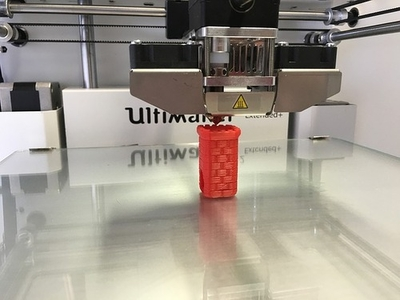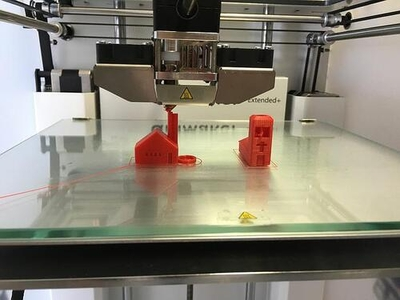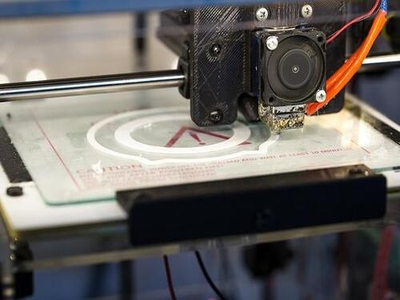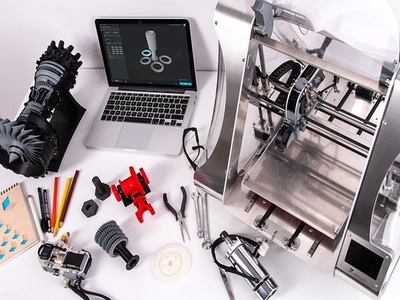What is retraction in 3D printing?
Retraction in 3D printing is the process of withdrawing the filament from the hot end of your 3D printer while it moves from point to point and helps prevent excess dripping.
In this blog post, we’ll discuss what causes excess dripping resulting in stringing and oozing, and how to fix these issues using retraction.
What Is Retraction In 3D Printing?

Retraction in 3D printing is the process of pulling back or retracting the print head and preventing excess filament from being forced out.
Excess filament results in over-extrusion, leaving behind strings of filament between points of the object being printed.
Retraction eliminates excess stringing by pulling back the printhead as it moves from one location to another.
This can be accomplished by tuning and/or enabling the settings on the printer itself or in the software program you utilize.
In either case, it’s important to maintain a consistent distance between the print head and the substrate to prevent smudging.
There are several factors that can affect retraction settings, including retraction distance and retraction speed.
Retraction distance refers to how much length of filament is pulled back by the extruder. The longer the distance, the longer the print will take.
Retraction speed refers to how fast that length of filament is pulled back.
This one is tricky to set as a speed too slow won’t relieve pressure fast enough while too fast of speed can break filaments.
For example, faster print speeds require greater retraction distances to prevent stringing between points.
In addition, some inks (such as UV-curable filaments) require longer periods of time to dry, so greater retraction distances may be needed to prevent stringing.
Finally, higher temperatures can also cause stringing and oozing, so it may be necessary to increase retraction distances when printing at higher temperatures.
Ultimately, the best way to figure out which distance-to-speed retraction ratio is ideal for your printer is to experiment.
Read More: 3D Printer Setup Guide. If you have a new 3D printer, you may not be looking forward to setup. We make it easy!
What Causes Stringing and Oozing?
When you print, have you ever noticed that your filament sometimes seems to string or ooze out, rather than printing in a clean, solid line?
This can be quite frustrating, especially if it happens frequently.
Before you can fix the problem, you need to find the root cause.
This could be anything from incorrect retraction settings to the temperate of the hot end being too high or the printhead moving too slow.
Read More: What is a Hot End On a 3D Printer? Discover more about hot ends, including our favorite options!
How To Fix This

Fortunately, there are a few things you can do to help reduce or eliminate stringing and oozing.
- First, make sure you’re using the right type of filament for your printer and your project.
- Second, clean your print head regularly to prevent clogs.
- And finally, make sure your printer settings are optimized for your project.
With a little care and attention, you can minimize stringing and oozing and produce clean, professional-looking prints.
How to Fix These Issues Using Retraction

There are several different approaches that can be taken to fix printing issues, including retraction.
Retraction refers to the process of pushing back the filament into the printhead as it is being extruded and moves from point to point.
This can help to minimize errors in print quality, such as poor adhesion or uneven printing.
Additionally, retraction helps to prevent stringing, which is when excess filament from an earlier layer gets pulled into the next layer and creates unwanted bumps.
Other fixes for printing issues include adjusting the feed rate and temperature settings on your printer, as well as calibrating the bed before printing.
Ultimately, the key to achieving better print results is to experiment with different settings and find what works best for your particular printer and material type.
With a little patience and practice, you should be able to find a solution to common 3D printing problems that will help you achieve consistently high-quality prints every time.
Check out this video showing you how to stop stringing with Retraction:
Examples of Successful Prints With Retraction Settings
One of the most important settings when it comes to 3D printing is retraction.
Retraction settings are designed to prevent unnecessary masses of plastic from extruding at various points as the printhead moves during the print process.
Retraction settings also determine how much plastic is drawn back into the nozzle before extrusion begins again, and can dictate how quickly this happens.
Keep in mind that different materials may require different retraction settings in order to achieve optimal results.
But, overall, retraction settings have a significant impact on the quality and consistency of your prints.
One example of a successful print with retraction settings is a detailed figurine or model of an animal or plant.
When printed using PLA filament and high-quality retraction settings, these models can look extremely lifelike as there are no visible gaps or mismatched textures due to oozing.
Another good example is an intricate piece with many small parts like a cog that seamlessly fits into its corresponding gear slot.
By precisely controlling your retraction settings, you can ensure that these small elements fit together perfectly every time,
Likewise, precise control can result in complex pieces free of defects and look as though they were produced by industrial machinery.
Whether you are printing functional components or fine sculptures, utilizing proper retraction settings will help you achieve consistently
Read More: How to Clean a Blocked 3D Printer Nozzle. Don’t let a blocked nozzle ruin your prints! Here’s how to clean nozzles.
What are the Benefits of Retraction?

Retraction is a key part of 3D printing that helps to ensure the accuracy and quality of the final product.
In simple 3D printing terms, retraction is the process of pulling the filament back into the printer nozzle while the print head moves to a different location.
This helps to prevent stringing, which can occur when the filament oozes out of the nozzle while the print head is moving.
Retraction can also help to improve layer bonding and reduce warping.
Overall, retraction is an essential part of the 3D printing process that helps to ensure high-quality prints.
What to Keep in Mind When Retracting Filament
When it comes to 3D printing, knowing how to retract your filament is essential for achieving high-quality prints.
There are a few key things to keep in mind when retraction.
First, you should always make sure to set your retraction speed as high as possible.
This will help minimize oozing and stringing while also minimizing time spent on retraction.
Additionally, it is important to carefully control the amount of filament that is being retracted during each retraction cycle.
Too much and there may be leaks or other problems, too little and you may still have issues with fabric inconsistencies and thin spots.
Overall, it is important to take the time to fine-tune your retraction settings for optimal results.
With practice, you can master this important step in 3D printing, resulting in perfectly printed objects every time.
Conclusion
In conclusion, retraction is a key part of the three-dimensional printing process that helps to ensure accuracy and quality in the final product.
By understanding what retraction is and how it works, you can take steps to optimize your own printing process and achieve perfectly printed objects every time.
Thanks for reading!
Read More